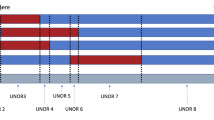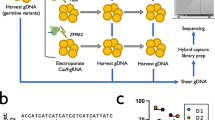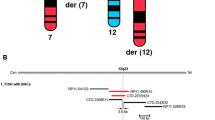Abstract
Hypomagnesemia with secondary hypocalcemia (HSH) is a rare inherited disease, characterised by neurological symptoms, such as tetany, muscle spasms and seizures, due to hypocalcemia. It has been suggested that HSH is genetically heterogeneous, but only one causative gene, TRPM6, on chromosome 9 has so far been isolated. We have now studied the genetic background of HSH in four Polish patients belonging to three families, and a HSH patient carrying an apparently balanced X;9 translocation. The translocation patient has long been considered as an example of the X-linked form of HSH. We identified six TRPM6 gene mutations, of which five were novel, in the Polish patients. All the alterations were either nonsense/splicing or missense mutations. The clinical picture of the patients was similar to the HSH patients reported earlier. No genotype–phenotype correlation could be detected. Sequencing did not reveal any TRPM6 or TRPM7 gene mutations in the female HSH patient with an X;9 translocation. Isolation of the translocation breakpoint showed that the chromosome 9 specific breakpoint mapped within satellite III repeat sequence. The X-chromosomal breakpoint was localised to the first intron of the vascular endothelial growth factor gene, VEGFD. No other sequence alterations were observed within the VEGFD gene. Even though the VEGFD gene was interrupted by the X;9 translocation, it seems unlikely that VEGFD is causing the translocation patient's HSH-like phenotype. Furthermore, re-evaluation of patient's clinical symptoms suggests that she did not have a typical HSH.
Similar content being viewed by others
Log in or create a free account to read this content
Gain free access to this article, as well as selected content from this journal and more on nature.com
or
Accession codes
References
Cole DE, Quamme GA : Inherited disorders of renal magnesium handling. J Am Soc Nephrol 2000; 11: 1937–1947.
Walder RY, Landau D, Meyer P et al: Mutation of TRPM6 causes familial hypomagnesemia with secondary hypocalcemia. Nat Genet 2002; 31: 171–174.
Pronicka E, Gruszczynska B : Familial hypomagnesemia with secondary hypocalcaemia – autosomal or X-linked inheritance. J Inher Metab Dis 1991; 14: 397–399.
Teebi AS : Primary hypomagnesaemia, an X-borne allele? Lancet 1983; 1: 701.
Meyer M, Mattei JF, Viallard JL, Goumy P, Dastugue B, Malpuech G : Hypocalcemie magnesodependante par trouble specifique de l’absorption du magnesium, associee a une anomalie chromosomique. Rev Franc Endocrinol Clin 1978; 19: 101–108.
Walder RY, Shalev H, Brennan TMH et al: Familial hypomagnesemia maps to chromosome 9q, not to the X chromosome: genetic linkage mapping and analysis of a balanced translocation breakpoint. Hum Mol Genet 1997; 6: 1491–1497.
Schlingmann KP, Weber S, Peters M et al: Hypomagnesemia with secondary hypocalcemia is caused by mutations in TRPM6, a new member of the TRPM gene family. Nat Genet 2002; 31: 166–170.
Montell C, Birnbaumer L, Flockerzi V : The TRP channels, a remarkably functional family. Cell 2002; 108: 595–598.
Runnels LW, Yue L, Clapham DE : TRP-PLIK, a bifunctional protein with kinase and ion channel activities. Science 2001; 291: 1043–1047.
Nadler MJ, Hermosura MC, Inabe K et al: LTRPC7 is a Mg.ATP-regulated divalent cation channel required for cell viability. Nature 2001; 411: 590–595.
Riazanova LV, Pavur KS, Petrov AN, Dorovkov MV, Riazanov AG : Novel type of signaling molecules: protein kinases covalently linked to ion channels. Mol Biol (Mosk) 2001; 35: 321–332.
Chubanov V, Waldegger S, Mederos Y et al: Disruption of TRPM6/TRPM7 complex formation by a mutation in the TRPM6 gene causes hypomagnesemia with secondary hypocalcemia. Proc Natl Acad Sci USA 2004; 101: 2894–2899.
Chery M, Biancalana V, Philippe C, Malpuech G, Hilgenkrantz S, Hanauer A : Hypomagnesemia with secondary hypocalcemia in a female with balanced X;9 translocation: mapping of the Xp22 chromosome breakpoint. Hum Genet 1994; 93: 587–591.
Huopaniemi L, Rantala A, Forsius H, Somer M, de la Chapelle A, Alitalo T : Three widespread founder mutations contribute to high incidence of X-linked juvenile retinoschisis in Finland. Eur J Hum Genet 1999; 7: 368–376.
Ganguly A, Rock MJ, Prockop DJ : Conformation-sensitive gel electrophoresis for rapid detection of single-base differences in double-stranded PCR products and DNA fragments: evidence for solvent-induced bends in DNA heteroduplexes. Proc Natl Acad Sci USA 1993; 90: 10325–10329.
Syvänen AC, Sajantila A, Lukka M : Identification of individuals by analysis of biallelic DNA markers, using PCR and solid-phase minisequencing. Am J Hum Genet 1993; 52: 46–59.
Alitalo T, Francis F, Kere J, Lehrach H, Schlessinger D, Willard HF : A 6-Mb YAC contig in Xp22.1-p22.2 spanning the DXS69E, XE59, GLRA2, PIGA, GRPR, CALB3, and PHKA2 genes. Genomics 1995; 25: 691–700.
Lehrach H, Drmanac J, Hoheisel J et al: Hybridization fingerprinting in genome mapping and sequencing. In Davies KE, Tilghman S (eds): Genome analysis: genetic and physical mapping. New York: Cold Spring Harbor, 1990, pp 39–81.
Siebert PD, Chenchik A, Kellogg DE, Lukyanov KA, Lukyanov SA : An improved PCR method for walking in uncloned genomic DNA. Nucleic Acids Res 1995; 23: 1087–1088.
Pinkel D, Straume T, Gray JW : Cytogenetic analysis using quantitative, high-sensitivity, fluorescence hybridization. Proc Natl Acad Sci USA 1986; 83: 2934–2938.
Wendler WM, Kremmer E, Forster R, Winnacker EL : Identification of pirin, a novel highly conserved nuclear protein. J Biol Chem 1997; 272: 8482–8489.
Yamada Y, Nezu J, Shimane M, Hirata Y : Molecular cloning of a novel vascular endothelial growth factor, VEGF-D. Genomics 1997; 42: 483–488.
Rocchigiani M, Lestingi M, Luddi A et al: Human FIGF: cloning, gene structure, and mapping to chromosome Xp22.1 between the PIGA and the GRPR genes. Genomics 1998; 47: 207–216.
Achen MG, Jeltsch M, Kukk E et al: Vascular endothelial growth factor D (VEGF-D) is a ligand for the tyrosine kinases VEGF receptor 2 (Flk1) and VEGF receptor 3 (Flt4). Proc Natl Acad Sci USA 1998; 95: 548–553.
Kerstan D, Quamme G : Physiology and pathophysiology of intestinal absorption of magnesium. In Massry SG, Morii H, Nishizawa Y (eds): Calcium in Internal Medicine. London: Springer-Verlag, 2002, pp 171–183.
Voets T, Nilius B, Hoefs S et al: TRPM6 forms the Mg2+ influx channel involved in intestinal and renal Mg2+ absorption. J Biol Chem 2004; 279: 19–25.
Minor DL, Lin YF, Mobley BC et al: The polar T1 interface is linked to conformational changes that open the voltage-gated potassium channel. Cell 2000; 102: 657–670.
Rissanen TT, Markkanen JE, Gruchala M et al: VEGF-D is the strongest angiogenic and lymphangiogenic effector among VEGFs delivered into skeletal muscle via adenoviruses. Circ Res 2003; 92: 1098–1106.
Stacker SA, Caesar C, Baldwin ME et al: VEGF-D promotes the metastatic spread of tumor cells via the lymphatics. Nat Med 2001; 7: 186–191.
Karkkainen MJ, Ferrell RE, Lawrence EC et al: Missense mutations interfere with VEGFR-3 signalling in primary lymphoedema. Nat Genet 2000; 25: 153–159.
Vu TH, Shipley JM, Bergers G et al: MMP-9/gelatinase B is a key regulator of growth plate angiogenesis and apoptosis of hypertrophic chondrocytes. Cell 1998; 93: 411–422.
Gosden JR, Mitchell AR, Buckland RA, Clayton RP, Evans HJ : The location of four human satellite DNAs on human chromosomes. Birth Defects Orig Artic Ser 1975; 11: 168–169.
Bagheri-Fam S, Ferraz C, Demaille J, Scherer G, Pfeifer D : Comparative genomics of the SOX9 region in human and Fugu rubripes: conservation of short regulatory sequence elements within large intergenic regions. Genomics 2001; 78: 73–82.
Pop R, Conz C, Lindenberg KS et al: Screening of the 1 Mb SOX9 5′ control region by array CGH identifies a large deletion in a case of campomelic dysplasia with XY sex reversal. J Med Genet 2004; 41: e47.
Mattei MG, Mattei JF, Ayme S, Malpuech G, Giraud F : A dynamic study in two new cases of X chromosome translocations. Hum Genet 1978; 41: 251–257.
Acknowledgements
Part of this study was performed at the Folkhälsan Institute of Genetics. This study was supported by the Helsinki University Hospital Grants TYH8301 and TYH1338, the European Communities Grant PL950889, Sigrid Juselius Foundation and Jenny and Antti Wihuri Foundation.
Author information
Authors and Affiliations
Corresponding author
Rights and permissions
About this article
Cite this article
Jalkanen, R., Pronicka, E., Tyynismaa, H. et al. Genetic background of HSH in three Polish families and a patient with an X;9 translocation. Eur J Hum Genet 14, 55–62 (2006). https://doi.org/10.1038/sj.ejhg.5201515
Received:
Revised:
Accepted:
Published:
Issue date:
DOI: https://doi.org/10.1038/sj.ejhg.5201515
Keywords
This article is cited by
-
Intestinal hypomagnesemia in an Iranian patient with a novel TRPM6 variant: a case report and review of the literature
CEN Case Reports (2023)
-
New TRPM6 missense mutations linked to hypomagnesemia with secondary hypocalcemia
European Journal of Human Genetics (2014)



